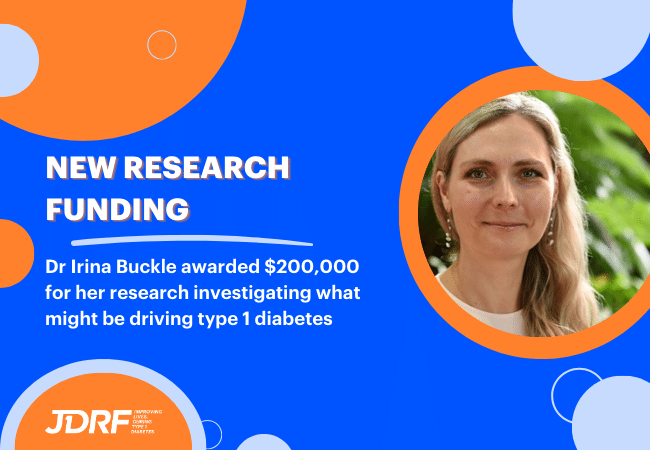T1D and Coronavirus: What You Need to Know
For the most up-to-date information about coronavirus in Australia, please visit the Department of Health website.
Update: Click here to read our comment on emerging COVID-19/T1D Research
News about the novel coronavirus—now named COVID-19 by the World Health Organization (WHO)–continues to dominate global headlines. As of March 11, the WHO has declared COVID-19 a pandemic. Many Australians, particularly those with type 1 diabetes and other chronic health conditions are understandably concerned. According to the Department of Health “Currently, Australia does not have widespread community transmission of COVID-19”. The people most at risk of getting the virus are those who have recently been in in a high-risk country/region and people who have been in close contact with someone who has a confirmed case of coronavirus.
However, COVID-19 and similar viral illnesses—such as the flu—can pose a serious risk for people with T1D.
Below are some fast facts about COVID-19, and what people with T1D need to know.
About the coronavirus (COVID-19)
What is COVID-19?
Coronaviruses are a family of viruses that cause respiratory illnesses. Most of them cause illness in animals, but seven known types of coronavirus cause illness in humans. COVID-19 is one of them. It is related to other coronaviruses that cause illness in humans such as SARS (Severe Acute Respiratory Syndrome) and MERS (Middle East Respiratory Syndrome).
What are the symptoms?
People who are confirmed to have COVID-19 have exhibited mild to severe respiratory illness with fever, coughing and shortness of breath. According to the WHO, some people may experience aches and pains, nasal congestion, runny nose, sore throat or diarrhea—though these symptoms usually develop gradually after the onset of the illness.
How will someone know whether they have COVID-19?
Generally, the virus is spread from person to person. If you have not been within six feet of someone who has it, your chances of contracting it are low. According to the Department of Health, “People who think they have been exposed to COVID-19 should contact their healthcare provider immediately. Call ahead of time to book an appointment. Tell your doctor about your symptoms, travel history and any recent close contact with someone who has coronavirus. If you must leave home to see your doctor, wear a surgical mask (if you have one) to protect others.”
What should I do to protect myself?
Since COVID-19 is so new, there is not yet a vaccine, nor are there medications to treat it. The Australian Department of Health has shared key recommendations everyone should practise to protect against infections. This includes washing your hands often with soap and water; avoiding touching your eyes, nose and mouth with unwashed hands; using a tissue and covering your mouth when you cough or sneeze; avoiding close contact with others, such as touching. Read more about protective measures against coronavirus on the World Health Organization website.
What should someone with T1D know about having a viral illness?
There is no evidence that people with T1D are more at-risk of contracting COVID-19.
– According to several physicians whose expertise includes T1D, thus far there is no evidence that people with T1D are more susceptible to contracting COVID-19. In theory, prolonged periods of high blood glucose can affect T-cell immunity – a key part of your immune system. Therefore, it’s possible that people with chronic elevated blood glucose levels may be at risk of more viral infections in general.
– Experts further say that if someone with T1D does contract COVID-19, they are not necessarily at higher risk of developing serious complications from the disease, but it’s possible that some people might be. Those at greatest risk are those who have another chronic disease, or additional health problems (such as a compromised immune system, heart disease or renal failure). COVID-19 is a new virus, and we will understand more about how it spreads and who is most at risk as time goes on. We will monitor this evidence and keep you updated as it becomes available globally.
– In general, when people with T1D do develop an illness it can be more difficult to treat due to fluctuations in blood glucose levels and other complications. We encourage you to refer to the advice that applies during infections with other viruses. If you have T1D and do become ill, with any virus, you must take special care of yourself and your T1D (see below).
If you have any concerns please contact your diabetes team or health care provider for advice on your sick day management. Some general guidelines on sick day management can be found below.
Monitor blood glucose and ketones more frequently.
– When you are not feeling well, you may be eating and drinking less, and you may be taking medication to address symptoms such as fever and muscle aches. Thus, it is crucial to carefully monitor your blood glucose and ketones more often than usual — as often as every four hours.
– Check your continuous glucose monitor (CGM) if you have one, or frequently use finger sticks.
– It may be necessary to take extra insulin to bring down higher blood glucose levels.
– Watch for ketones, as very high levels could lead to diabetic ketoacidosis (DKA), a dangerous condition that can be fatal if left untreated. Elevated ketone levels often occur when blood sugar readings are high, indicating that the body is using fat and muscle for energy, instead of sugar.
– Signs of DKA include flu-like symptoms (feeling tired, weak, aches, nausea or vomiting, abdominal pain), dehydration and also a fruity smell to the breath with more rapid breathing, which happens when the body is trying to eliminate the ketones and acid.
– Contact your healthcare provider immediately with vomiting, moderate to large ketones or any other symptoms of DKA.
It is more important than ever to continue a normal schedule of medications.
– This can be challenging, especially if you’re having a hard time keeping food and liquid down.
– Beyond insulin, many over-the-counter medications also affect blood glucose levels. Many cough syrups contain sugar, which can exacerbate already high blood glucose levels. Pills —that have the same ingredients as syrups—may be a better alternative if they contain no carbohydrates.
– Other medication like decongestants also raise blood glucose.
– Be aware of the effects of pain and fever reducers.
Stock your cabinets with items that will support a healthy intake of carbohydrates.
– Crackers, vegetable or noodle soups, or fruit-flavoured yogurt are all easy-on-the-stomach selections.
– If too difficult to swallow, liquids can be a short-term solution.
– If blood sugars are in range, start with drinks that contain carbohydrates, and plan to consume something every three to four hours including fruit juices, sports drinks and regular soft drinks.
– Staying well hydrated helps flush out ketones. Increase your intake of carb-free choices like water, broth, and sugar-free gelatine, ice blocks or soft drinks.
Be prepared, just in case.
– It is vital to be ready for the worst, even if (hopefully) you never have to experience it.
– Have your doctor’s phone numbers (including how to reach them at night and on weekends or holidays) ready in case you experience: vomiting or diarrhea for more than six hours; shortness of breath; a fever for more than a couple of days; large levels of ketones; and an inability to keep food or liquid down.
– For children, call a doctor if they: have trouble breathing or exhibit blue lips; won’t eat or drink; experience severe ear pain; and are much more sleepy than usual.
– If you end up at the emergency room, it is vital that you mention that you or your loved one has T1D or have an ID bracelet prominently displayed.
Supply chain issues
Is COVID-19 disrupting the T1D supply chain?
We have received multiple questions from many of you about the availability of critical T1D medications and supplies. We also understand that some of you have had to deal with delays or shortages at your local pharmacies due to an increase in demand. Our information to date is that any local shortages are most likely a direct effect of people stockpiling supplies rather than any underlying supply issue. JDRF has received no notifications that there are or have been disruptions in the T1D supply chain. JDRF will remain in close contact with the leading manufacturers of insulin and T1D supplies. These manufacturers have communicated to us that COVID-19 is not having an impact on their current manufacturing and distribution capabilities. We will continue to monitor the situation and update the T1D community should anything change.
Some companies have distributed public statements about their supply chains (listed below). We will provide more updates as we receive new information.
Novo Nordisk: “During the global coronavirus outbreak, our key priority is to safeguard the continued supply of our lifesaving medicines to patients. The situation is continually evolving, but currently we are not experiencing any supply constraints. We are well prepared for situations like this and have an inventory policy that serves long-term supply. This is important since our medicines are needed every day by patients all over the world.”
Roche: “With regards to the supply of our medicines and therapies, we have initiated plans to ensure the outbreak of COVID-19 does not impact supply in Australia and feel confident in our ability to continue to provide medicines to patients for the foreseeable future. We continue to monitor demand to mediate potential supply risks. Based on current demand forecasts, we do not anticipate supply interruptions or shortages for any Roche product currently available for Australian patients.”
AMSL: “We would like to advise that there is no shortage of essential products such as insulin pump consumables and continuous glucose monitoring devices. All our manufacturers are fully operational and have had no interruptions with their supply chain. We strongly suggest that you order as per your normal routine and not to over order as this would not be fair to others trying to get supplies across the country. Please be mindful of others when you are placing your order.”
Sanofi: “The supply of Sanofi diabetes medicines in Australia is currently unaffected by recent developments related to COVID-19. We will continue to monitor the situation and provide JDRF with an update should this situation change. Those concerned about their current prescription should talk to their healthcare professional.”
Additional information
You can read more about COVID-19 and children with T1D in our Q+A with paediatric endocrinologist Professor Liz Davis here.
You can read more about adults with T1D and COVID-19 in our Q+A with consultant endocrinologist A/Prof Spiros Fourlanos here.
For detailed information about COVID-19, visit the Department of Health and World Health Organization (WHO) websites.
For more information about managing sick days with T1D, read the NDSS factsheet Managing sick days for type 1 diabetes.
This post is a localised version of an article originally published by JDRF here.




